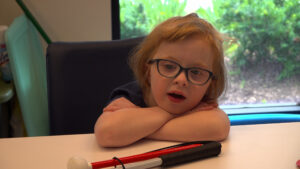Orientation and Mobility Activities for Families of Blind/Low Vision Children
This content is also available in:
Español (Spanish)
Here are some fun activities that can help reinforce orientation and mobility (O&M) skills for children who are blind or have low vision. These activities are great for children aged six and up, including siblings, cousins, or friends. Feel free to modify and expand on these as you discover what your child enjoys.
In the House

- Hide-n-Seek: When your child is “it,” have them describe where they found you, like “behind the door” or “in the bathtub.” This helps them understand the relationship between objects and people, an important skill for future travel.
- Playing a Guessing Game: Ask, “I eat in the __________,” and see if they can find the right area of the house. Reward correct guesses with stickers or points. This teaches the function of different rooms, helping them understand how spaces are used in daily life.
- Cleaning Up Toys: Encourage your child to help put away toys. This teaches them to organize their space, which is crucial for school success. Organized children often perform better academically and socially.
- Having a Job or Role: Assign your child simple tasks like feeding a pet, picking up clothes, or getting the mail. This gives them a sense of responsibility and belonging within the family.
Outside Games
Choose games and play according to your child’s personality, strengths, and needs. Children sensitive to various textures may not want to walk barefoot in the grass or play in a sandbox. Learning to tolerate different textures is important because the world is full of them, providing us with so much information.
The sun itself can be challenging for those who are sensitive to light. Children who are blind or low vision may need to wear sunglasses, hats, and sunscreen. Helping them be more comfortable in unpredictable and often uncomfortable situations is always desirous. Trying to have a fun activity as the goal, like walking to a swing, can often help minimize your child’s aversion to whatever she doesn’t like.
- Games: Incorporate beeping balls or balls with bells into your child’s favorite games. These adaptations make it easier for them to participate.
- Swimming Lessons: Find a swimming instructor who can work with your child. Swimming is excellent for building physical strength and coordination.
- Outings: Take trips to the zoo or theme parks. Inform venues of your child’s needs for possible special accommodations, enhancing their experience and understanding of the world.
- Hippotherapy (Horse Riding): Horse riding can be therapeutic and may be covered by insurance or local agencies. It improves walking patterns by mimicking human gait.
- Picnics: Involve your child in planning and preparing for a picnic. They can help make a shopping list, retrieve items, and make sandwiches. For older kids, let them shop on their own and ask for help from store clerks.
Traveling in the Car or Riding a Bus
- Playing “I Spy”: For children with low vision, use a monocular to spot cars or traffic signs. This practice helps them use their vision effectively. You can use monocular or binoculars or other AT devices they are using.
- Using a Smartphone or GPS: Enable your child to use apps that announce directions and landmarks. This helps them learn about their environment in real-time, preparing them for independent travel.
Theme Parks and Zoos
- Creating Excitement: Prepare your child for visits by sharing information about the place beforehand. This can make them excited and less anxious. Even if they can’t touch or see everything, they can still enjoy different terrains, temperatures, and smells.
- Making a Tactile Map: Use Elmer’s glue to create a tactile map. Outline where you are and where you’re going. This can be a fun activity and is helpful for understanding the layout. You can also ask for help from your child’s orientation and mobility specialist, teacher, braillist, or caseworker. They might have tactile map-making kits available for you to borrow.
- Encourage your child to determine where the store is in relation to the car by listening or looking around.
- Use landmarks to remember parking spots.
- Listen for traffic, can they tell you where to cross from the parking lot to the store?
- Inside, have them identify the location of cash registers and navigate using store maps or by asking for assistance.
- Identify a new fruit or vegetable in a store’s produce section and if there’s time, trying it at home is a great follow up activity.
Having Friends Over or Visiting Friends
- Planning Activities: Involve your child in planning activities when friends come over. If spending the night at a friend’s house, familiarize them with the layout of the home.
Restaurants and Cafeterias
- Explaining Rules and Environment: Prepare your child for the noises and smells they will encounter. Explain different sounds and their sources to help them adapt to noisy environments, crucial for outdoor travel.
- Explain the Various Staff Roles: This is an opportunity for children to be exposed to many different people and jobs they may not engage with. Consider hostesses, managers, chefs, and dishwashers to inform your child of the different roles people have.
Getting Together with Friends and Family
Hosting and Participating in Activities
Come up with accessible games and activities for gatherings. Everyday tasks like grocery shopping can be a learning experience, helping your child gain confidence and independence.
These activities not only support your child’s O&M skills but also integrate them into everyday life, building confidence and independence.